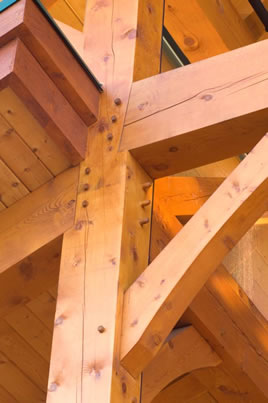Solid-sawn heavy timber is oversized structural softwood lumber that is 6 inches or more in its smallest cross-sectional dimension. Timbers are used predominantly as large, visible supports in construction, with both structural and aesthetic functions. Construction with timber is an alternative to the more common 2x4 construction, with the timbers supplying some of the structural support for the building. Some manufactured products, such as glue-laminated beams or laminated veneer lumber, can be used in similar applications.

Technical information
Solid-sawn heavy timbers are generally available in widths from 6 to 12 inches and in thicknesses from 6 to 20 inches. Lengths are commonly 16 to 30 feet or longer, with the longer lengths commanding a premium. Timbers are used as horizontal structural elements (beams) that are generally rectangular in cross-section, and also as vertical elements (posts or columns) that are typically closer to square.
Because of the tree diameters necessary to produce lumber of this size, larger timbers are usually produced from west coast species groups such as Douglas-fir-larch, hemlock-fir and western red cedar. Timbers are usually surfaced and sold “green,” since their large sizes makes drying costly.
They are graded on the basis of the characteristics that affect both their appearance and strength (e.g., size and location of knots, slope of grain, checks, wane, warp and manufacturing defects). Since timbers are often used in exposed locations, they are usually not grade marked; instead, a mill certificate confirms the grade.